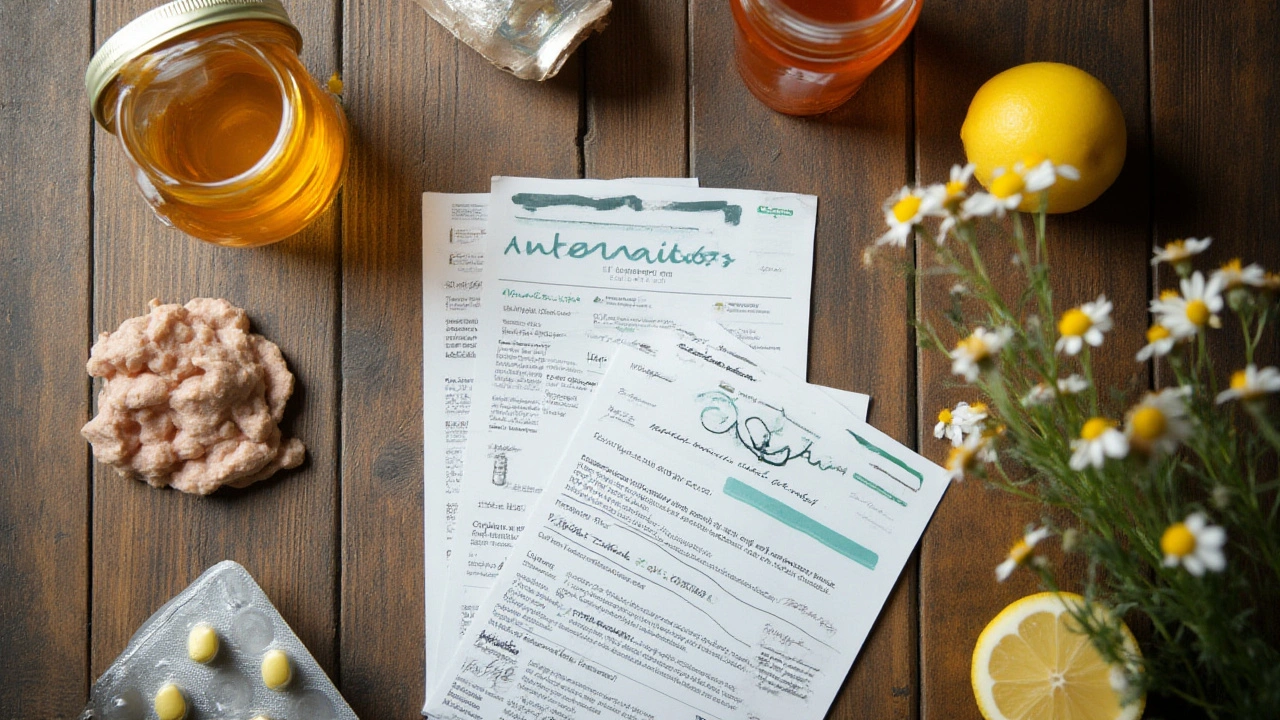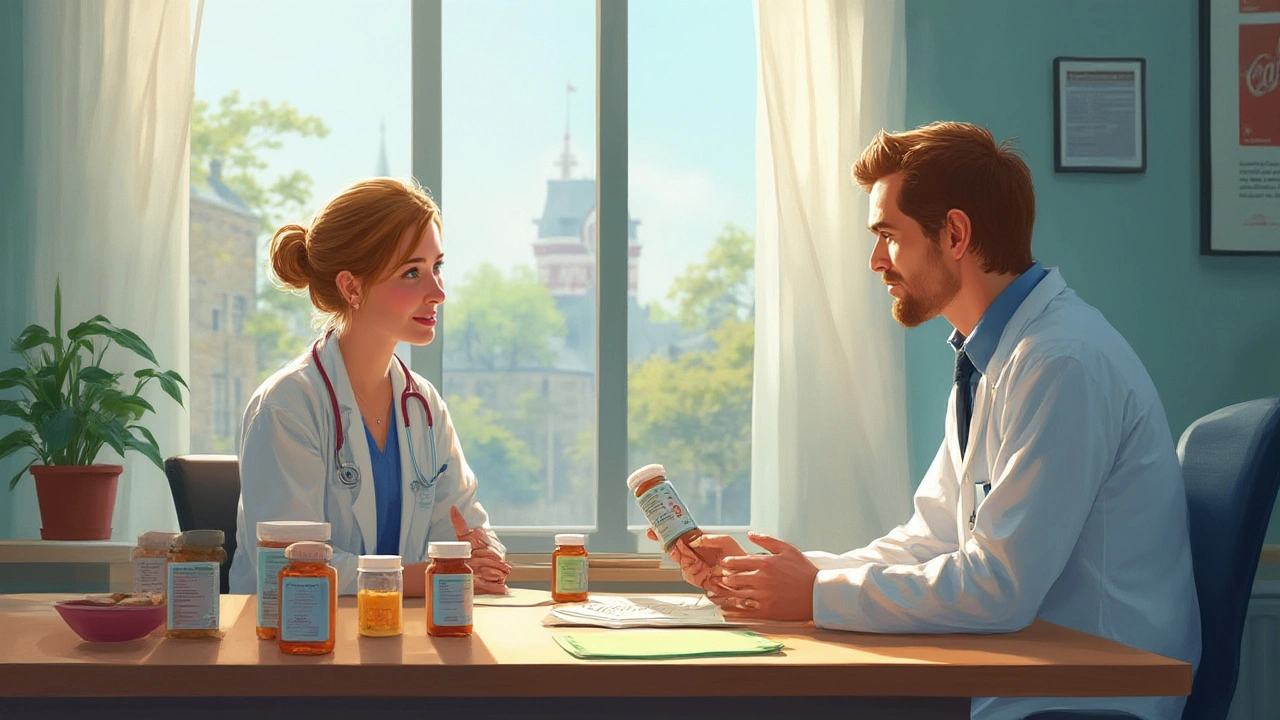Ever needed an antibiotic and were told Flagyl (metronidazole) was your best bet? What if it triggers headaches, gut issues, or just doesn’t suit you? Truth is, not everyone does well with Flagyl. Infections strike when you least expect, so knowing what else is available can save your sanity – and maybe a few days of misery.
Flagyl: What It Is, Where It Shines, and Why People Seek Alternatives
Flagyl, known in the pharmacy world as metronidazole, is often the first prescription handed out for things like bacterial vaginosis, trichomoniasis, giardiasis, and certain dental infections. It’s a tough pill, literally, knocking out anaerobic bacteria and some single-cell parasites. But no medicine is sunshine and rainbows. GI upset, metallic taste, dark urine, and—rare but alarming—liver issues are all flagged as side effects. Some people even get nerve issues with long-term use. Let’s not dance around it: mixing Flagyl with alcohol is a recipe for feeling horrible—think nausea, vomiting, pounding headache.
Doctors will tell you it gets the job done, but there’s another side to this story. What about people allergic to metronidazole? Or those dealing with chronic gut conditions who can’t afford another digestive battle? Every person’s body reacts in its own way, and sometimes, Flagyl just isn’t the hero.
Prescriptions That Step In: Tinidazole, Nitazoxanide, and Their Peers
Lucky for us, medicine never stops moving forward. Tinidazole is usually the first suggestion when Flagyl fails or causes problems. Structurally, it’s a cousin to metronidazole—just a bit less harsh on the stomach, and with a half-life that allows for once-daily dosing. Studies from the early 2020s put tinidazole at similar cure rates for trichomoniasis and giardiasis, with some patients swearing it feels easier on their gut.
Nitazoxanide enters when protozoa get stubborn. Initially launched for cryptosporidium and giardia infections, it’s sometimes used off-label for other bug battles too. Its secret weapon is a different mechanism from Flagyl, so if one fails, the other can have better luck.
For those stuck with unusual infections or who’ve cycled through the common drugs, doctors reach for secnidazole (one dose, very convenient), or paromomycin (especially when treating pregnant women or people worried about systemic effects). The most important thing: alternatives exist, and tailoring treatment isn’t just a buzzword. Real people get real relief when doctors look beyond their first-choice signature.
Paromomycin stands out for being non-absorbed, making it a safe bet during pregnancy or in folks who are terrified of systemic side effects. Meanwhile, clindamycin is an old-school antibiotic still used off-label for some vaginal infections, usually as a backup when other options flop.

Natural Alternatives: Science-Backed or Hype?
Here’s where things get lively. Social media raves about everything from garlic to silver, but which natural alternatives actually hold up in scientific studies? Oregano oil shows the most promise. A study published in 2021 revealed it had a strong effect against Giardia lamblia in lab settings, thanks to carvacrol and thymol compounds. Some clinics recommend 200 mg capsules daily (separately from prescription meds), but gummies and tinctures float around on store shelves too. That said, one word: caution. Oregano oil is potent and can irritate the GI tract, so don’t try chugging it straight or for long periods without a professional’s say-so.
Garlic, with its allicin content, is another natural hero. Before pharmaceuticals, people chewed raw garlic or brewed teas for various infections. The evidence? One clinical trial found garlic extract reduced symptoms of bacterial vaginosis almost as well as metronidazole gel. But you’d need a lot of raw garlic to match pill form potency—think daytime vampire deterrent level.
Other herbal options like berberine, goldenseal, and black walnut have tradition on their side but far fewer human studies. Berberine has shown mild activity against Giardia and bacteria in small research trials but can cause low blood pressure or interact with other meds. Don’t skip checking with a doctor or pharmacist regarding these interactions.
For anyone exploring the internet rabbit hole, you’ll run into items like colloidal silver, tea tree oil, and even oil of oregano enemas touted as miracle cures. Don’t risk your health here. These remedies lack solid data and can cause harm (or at the very least, a miserable bathroom experience). Probiotics such as Saccharomyces boulardii or Lactobacillus rhamnosus can help restore healthy gut flora after antibiotics but won’t treat the infection directly.
How to Weigh Your Options: Science, Symptoms, and Lifestyle
Not all infections are created equal, and neither are alternative treatments. Here’s the reality: a self-diagnosed “yeast infection” might actually be bacterial or protozoal, which needs more than a probiotic or essential oil. Always start with an accurate diagnosis—at home tests can be a decent starting point, but lab confirmation is best.
Hospital and clinic protocols often start with metronidazole or tinidazole for protozoal infections. Still, if you can’t stomach these, talk to your doctor about alternatives to Flagyl. Your comfort—and long-term gut health—matter more than sticking to any strict playbook.
Some people swap drugs two or three times before finding one they don’t react badly to. One tip? Keep a written log of your side effects and what you tried. This record can make those follow-up doctor appointments super productive. If you lean toward the natural route, have a frank conversation about safety. There’s no shame in combining prescription meds with supplement support, especially if you want to shore up your immune system or soothe your GI upset.
For numbers people, here’s a snapshot of comparative cure rates (from published clinical studies):
| Treatment | Giardia Cure Rate | Bacterial Vaginosis Cure Rate |
|---|---|---|
| Flagyl (Metronidazole) | 85-95% | 80-90% |
| Tinidazole | 92-95% | Not typically used |
| Nitazoxanide | 80-85% | Rarely used |
| Oregano Oil | 72-82% (in vitro; small human trials) | Anecdotal |
| Garlic Extract | 60-70% (in vitro) | 70-80% (limited studies) |
It’s not all about numbers, though. Personal history (allergies, chronic gut conditions, pregnancy status) narrows down choices. Time, cost, pill size, and even taste matter. Tinidazole, for example, is often more expensive but may mean fewer pills and less stomach drama. Garlic and oregano oil are cheap, but not everyone loves their breath after a dose.
Don’t discount mental health either. When you feel lousy on a medicine—even if it’s technically “working”—that matters as much as the infection itself. Your comfort, quality of life, and energy level are major parts of feeling truly better.
- Keep a symptom calendar
- Work with a trusted healthcare provider
- Evaluate every option: side effects, price, convenience

The Bottom Line: Finding the Right Fit for You
The world isn’t one size fits all—why should antibiotics be? Flagyl still reigns as the standard choice for bacterial and protozoal infections, but it’s not the only contender. Tinidazole and nitazoxanide bring their own benefits to the table. When it comes to alternatives to Flagyl, science-backed natural remedies like oregano oil or concentrated garlic offer some promise, as long as you’re realistic about their limits.
If you get hit with tough side effects or your infection just won’t quit, there’s no shame in exploring new ground. Whether it means swapping prescriptions or adding natural supports, the real win is finding something that actually brings relief. Life’s too short for medications that make you miserable. Trust your gut—literally. Be open with your doctor, ask the awkward questions, and chase the solution that lets you get back to living without infection symptoms stealing your day.


Dharmendra Singh
July 18, 2025
This post about alternatives to Flagyl is really insightful. From my experience in India, many natural remedies like turmeric and neem have shown some antibacterial properties, which can complement or sometimes substitute medications under certain conditions.
Of course, one must be careful and consult reliable sources before replacing prescription drugs, as infections can be serious. Metronidazole (Flagyl) is widely prescribed here, but alternatives such as tinidazole or secnidazole might be considered if there are issues with tolerance or resistance.
On the natural side, probiotics are gaining recognition for gut health, potentially reducing the need for antibiotics in minor cases. However, more clinical trials are needed to confirm their effectiveness against protozoal infections.
So, it's a balance of medicinal science and traditional knowledge. Hopefully, this guide expands further on those options. Anyone had direct success with these natural alternatives combined with medicine?
Rocco Abel
July 21, 2025
Honestly, I’m extremely skeptical about the push towards natural alternatives for something like Flagyl. Most people don’t realize the pharmaceutical industry pushes certain antibiotics to control the market, but it’s clear from leaked documents and alternative studies that the real solutions are often hidden.
For example, there are herbs and extracts from plants historically used for protozoal infections that pharmaceutical companies don’t promote because they are not patentable. Yet, these treatments could be safer and less likely to induce resistance.
Have you ever wondered why metronidazole has been the go-to for so long despite known side effects? The conspiracy theorist in me suspects an agenda to keep patients dependent on synthetic drugs.
So while I’m interested in prescription alternatives, I strongly believe natural remedies deserve much more attention and research than mainstream medicine allows.
Dawn Mich
July 21, 2025
I have to jump in here because the paranoia about pharmaceutical conspiracies sometimes overshadows the genuine risks of dismissing well-studied medications like Flagyl. People who self-medicate with unproven alternatives risk dangerous complications.
Metronidazole is effective because it’s extensively researched and prescribed worldwide with a well-understood safety profile. Throwing natural remedies into the mix without solid evidence is reckless and irresponsible.
Yes, it’s great to explore alternatives, but that must be done with scientific rigor. Otherwise, we’re just chasing hype at the expense of actual patient safety. The guide itself should emphasize caution and the importance of consulting healthcare professionals rather than encouraging unsupervised natural treatments.
Anyone who thinks otherwise might want to reconsider how they evaluate health information critically.
Eric Sevigny
July 24, 2025
I appreciate all the perspectives here. As a healthcare provider in Canada, I often encounter patients interested in alternatives to antibiotics like Flagyl for various infections.
While prescription options such as tinidazole provide similar action, natural alternatives including garlic extract and berberine show promising antimicrobial properties in preliminary studies. However, clinical efficacy and safety at therapeutic doses remain to be conclusively established.
What I recommend to patients is a complementary approach: using prescribed medicine where necessary but supporting gut flora with probiotics and nutrition to improve recovery. Also, careful monitoring is key to avoid complications.
It would be useful if this guide included clearer disclaimers about consulting doctors and the limits of natural treatments to guide balanced decision-making.
Glenda Rosa
July 25, 2025
Honestly, the mainstream obsession with antibiotics is overrated and frankly hazardous. The pharmaceutical fields churn out the same chemicals repeatedly expecting different results while ignoring vibrant, rich botanicals that humans have used for millennia.
Most people are too scared to step outside the prescription bubble, fearing ‘scientific rigor’ but missing the fact that much pharma “science” is corrupted or biased. You want alternatives? Black walnut hulls, wormwood, and clove oil are among powerful natural agents that can combat protozoal and bacterial infections.
Why waste your body on synthetic drugs laden with side effects when Mother Nature offers superior, holistic remedies? Wake up and dive deeper into these radical, genuine options instead of parroting the pharma-sponsored narrative.
charlise webster
July 26, 2025
Glenda, your diatribe on pharmaceutical meds being ‘hazardous’ is quite the spectacle. Those so-called 'millennial' botanicals you rave about aren’t always the panacea you yer on about.
Each natural substance you mentioned has its own toxic profile if not used cautiously and doses standardized. Furthermore, lab evidence is not enough to justify overpowering clinical endorsement.
I'm all for alternatives, but you need to hold these claims to credible scientific scrutiny. The die-hard anti-pharma sentiment isn’t constructive unless grounded in factual, reproducible data. Let's keep it real, not just theatrical.
lata Kide
July 28, 2025
OMG 🙄 seriously people, like, how can you doubt the power of natural herbs?! My family has been using natural alternatives for generations, and no, we don’t just blindly trust pharmaceutical companies full of their toxic chemicals!!! 💪🌿
You don’t need to be some doctor to know what’s in your food or your body. If you want to get rid of infections NATURALLY, you have to listen to your body and trust the tradition. Flagyl is so harsh; it messes up your whole system!
I’m all about combining traditions and modern medicine but pushing patients to just swallow pills blindly is so outdated! People wake up!!! There are tons of natural options that work JUST as well.
And yes, probiotics and herbal teas help a ton too ❤️💚🙏
Mark Eddinger
July 31, 2025
From an objective standpoint, it is imperative to emphasize the importance of adhering to evidence-based treatments for infections. Metronidazole remains the first-line antibiotic because of its extensive clinical trials supporting its efficacy and safety profile.
While natural substances provide interesting phytochemical compounds with antimicrobial properties, they often lack the robust pharmacokinetic and pharmacodynamic data required for widespread medical endorsement.
That said, ongoing research into these compounds could one day supplement or provide alternatives to current antibiotics. Until then, the prudent course is to follow clinician guidance and not substitute prescription medications with unproven remedies.
It is also essential to recognize the dangers of antibiotic resistance and ensure proper use of any antimicrobial agent.
Francisco Garcia
August 3, 2025
This discussion raises fascinating cultural and scientific questions. In many societies, traditional medicine is the frontline defense against infections before western antibiotics became widespread. It’s a delicate balance between respecting culturally embedded remedies and acknowledging modern medical advances.
What intrigues me is how receptiveness to either approach varies by country and community. Some cultures pride themselves on time-tested herbal treatments while others trust pharmaceutical prescriptions unequivocally.
In my view, interdisciplinary research combining ethnobotany, microbiology, and clinical trials could illuminate which natural substances have real potential to be developed into standardized medications alongside or instead of existing drugs like Flagyl.
Engaging with local knowledge holders respectfully, without dismissiveness, is key to unlocking safer and accessible treatment options globally.
Patrick Renneker
August 9, 2025
It behooves us to contemplate, in the grand scope of pharmacological history, the diverse spectrum of therapeutic agents deployed for bacterial and protozoal infections beyond the ubiquitous metronidazole.
Indeed, despite the predominance of Flagyl, its known adverse effects compel the medical fraternity to consider viable prescription alternatives, such as ornidazole or secnidazole, with comparable efficacy but perhaps differing tolerance profiles.
Furthermore, the exploration of natural compounds—rooted in ethnomedical lore yet progressively substantiated by modern phytochemical analyses—presents an exciting yet rigorously presumptive frontier.
Nonetheless, the path from traditional usage to validated clinical application is labyrinthine, necessitating painstaking, controlled trials and meta-analyses to affirm safety and effectiveness.
Thus, while the guide serves as a commendable primer, it must be read with a discerning eye to the gradations of empirical support underpinning each alternative.
KAYLEE MCDONALD
August 17, 2025
Thanks everyone for the thoughtful comments here. It’s clear that when it comes to alternatives to Flagyl, caution and consultation with healthcare providers is paramount.
I empathize with those who seek natural or less harsh alternatives, but it’s important not to dismiss the risks involved with infections or unregulated treatments. I encourage people to be assertive in asking their doctors about options and to get comprehensive information rather than making unilateral decisions.
Ultimately, balancing efficacy, safety, and individual preferences will lead to the best outcomes. I’m glad this guide is bringing this conversation to the fore.